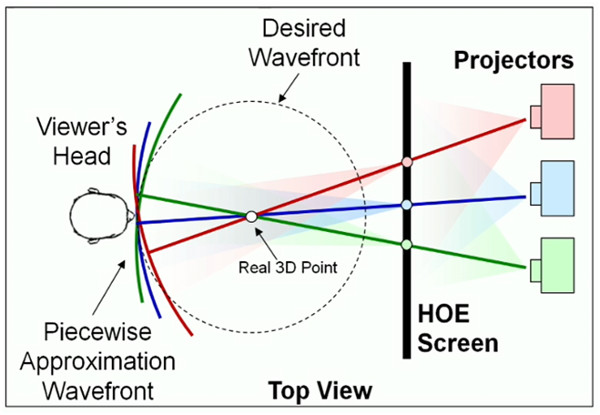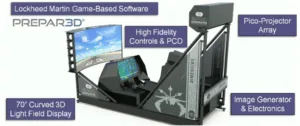Third Dimension Technologies showed off its projector-based light field simulator display at I/ITSEC 2016. They showed a similar demo at last year’s show, but this year they had a full fifth generation fighter cockpit to add more realism to the demo. This is the first time they have publically demonstrated this capability. But it may be the last time too – they have to deliver the simulator to the Air Force research Labs (AFRL), Human Performance Wing on January 10, 2017 as part of their development contract.
The system uses 22 commercial projectors, each with around 500 lumens of light output. These are arranged as a dense packed array and illuminate a 70” diagonal screen composed of holographically optical elements (HOE). These features are designed to reflect and distribute the light into a 1-degree horizontal angle and 90-degree vertical angle. Each projector illuminates the full screen with a different angular view of the scene, with 3-5 views simultaneously arriving at each eye. The result is a 3D image that has a look around capability in the horizontal direction and a decent size viewing eyebox (about 22″ at 5′ [56cm x 1.52m] in the case of this flight simulator). Most importantly, the system creates a real light point so there is no mismatch between vergence (eye convergence) and accommodation (focus), which does occur with almost all other stereoscopic and autostereoscopic 3D displays.
This design provides only horizontal parallax, but is much less computationally intensive than a system that offers both horizontal and vertical parallax. It is not a true holographic display system as it creates an approximation of the real wavefront, but such a display may meet the needs of users in many cases.

As shown in the photo, there is a cockpit with high-fidelity controls and a touch-screen instrument panel. The system runs the flight simulation program called Prepar3D (based on the old Microsoft Flight simulator program).
I had a chance to try this simulator last year and again this year. While the display technology has not changed much, the addition of the actual cockpit controls creates a much more realistic feel to the experience. Resolution is still modest compared to most simulators on the show floor, but the system was unique in its ability to create a glasses-free 3D image. Moving your head in the eyebox showed only some minor artifacts. The company is looking to develop the system into commercial simulator products and is seeking additional grants from military and government sources. – CC

